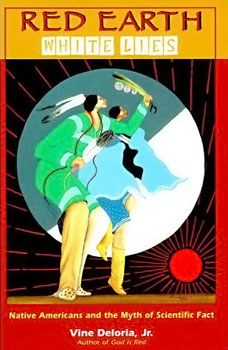Red Earth, White Lies facts for kids
 |
|
| Author | Vine Deloria, Jr. |
|---|---|
| Country | |
| Language | English |
| Subject | Creation beliefs of American Indians |
| Genre | Historical criticism |
| Publisher | Fulcrum Publishing |
|
Publication date
|
1997-08-19 |
| Media type | Paperback |
| Pages | 288 |
| ISBN | 1-55591-388-1 |
Red Earth, White Lies: Native Americans and the Myth of Scientific Fact is a book written by Native American author Vine Deloria. It was first published in 1995. The book's main idea is to question common scientific beliefs. Deloria felt these beliefs created a "fictional story" about early North America. He wanted to show different ways of understanding the past.
Exploring Ancient Americas
This book mainly looks at ideas about how people first came to the Americas. One big idea it questions is the Bering land bridge theory. This theory suggests that early humans walked from Asia to North America across a land bridge. Deloria tried to point out what he saw as weak spots in this theory. He looked at old discoveries and suggested other ideas. He believed these ideas fit better with how he understood Native American origins.
Deloria also disagreed with the "overkill hypothesis". This idea suggests that early humans hunted too many large animals. This hunting might have caused many big animals, like mammoths, to die out. This happened during the Pleistocene Ice Age in North America. Deloria thought this idea was unfair. He argued that similar large-scale extinctions did not happen in other parts of the world, like Asia. Even though humans also hunted there.
Deloria compared the main migration theory to "academic folklore." He said that even though people often stated it as fact, it was not always closely checked. He also argued that these popular theories did not match Native American oral traditions. These traditions, he said, do not include stories of people moving between continents. Deloria suggested a "Young Earth" idea, meaning the Earth is not as old as many scientists believe. He also talked about a worldwide flood and even believed that dinosaurs might have lived until the 1800s.
What Others Thought
Not everyone agreed with Vine Deloria's ideas in Red Earth, White Lies. John Whittaker, a professor of archeology, strongly disagreed with the book. He called it "a wretched piece of Native American creationist claptrap." He felt it had similar problems to other creationist writings. Whittaker noted that Deloria's style was like those who try to prove science wrong. This happens when scientific facts do not match certain belief systems.
Another scholar, Michael D. Gordin, saw connections between Deloria's book and the works of Immanuel Velikovsky. Velikovsky was a writer who believed old myths and traditions were important for understanding history. Deloria admired Velikovsky's ideas. Gordin thought Deloria's rejection of the Bering land bridge came from Velikovsky's ideas about big disasters in history. However, Velikovsky himself did not support creationism.

